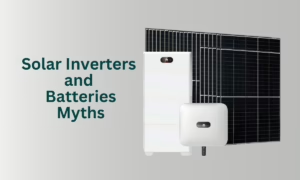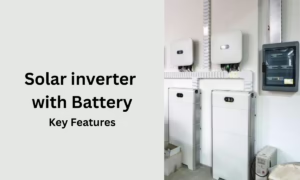Solar power has emerged as a game-changer in the ever-evolving domain of renewable energy, revolutionising how we harness the sun’s plentiful energy to generate electricity. Photovoltaic (PV) modules, often known as solar panels, are at the heart of solar energy systems, absorbing sunlight and converting it into clean, sustainable electricity. Solar panels, the ingenious photovoltaic modules that absorb the sun’s radiant energy and turn it into clean, renewable power, are at the heart of the renewable revolution. With advances in solar technology, the Indian market is now realising the many advantages and conveniences of solar panels. The entire outlook on the solar shift has been changed. As solar technology progresses, the Indian market is becoming swamped with a diverse range of solar panels, each with its own set of benefits and efficiency levels. In this in-depth essay, we will look at the four major types of solar panels available in the Indian market: monocrystalline modules, polycrystalline modules, thin film modules, and MONO PERC modules.
Homeowners and businesses may make well-informed choices when picking the best solar panels for their energy needs if they understand the differences and benefits of each type. In this comprehensive blog, we will explore the four major varieties of solar panels available in the Indian market, putting light on their strengths, benefits, and applications. Consumers may make informed choices that match their energy demands, environmental aims, and financial considerations by learning more about these solar panels, thereby contributing to a cleaner and more sustainable tomorrow.
1. Monocrystalline Modules:
Monocrystalline solar panels are well-known for their efficiency and attractive appearance. They are constructed from single-crystal silicon cells, giving them a more uniform look with a black or dark blue colour. Monocrystalline panels are made by cutting cylindrical silicon ingots into thin wafers, which are subsequently stacked into cells. Monocrystalline modules are well-known for their excellent energy conversion efficiency, which normally ranges between 15% and 20%.
Benefits of Monocrystalline Modules:
- Higher Efficiency: Because of their homogenous structure, monocrystalline panels have a higher energy conversion efficiency, making them perfect for small roof spaces.
- Aesthetically pleasing: Monocrystalline panels’ sleek and dark appearance combines well with diverse architectural types, making them a popular choice for residential installations.
- Space Efficiency: Monocrystalline panels require less room to produce the same amount of energy as other varieties, making them ideal for installations with limited space.
2. Polycrystalline Modules:
Another popular alternative in the Indian solar market is polycrystalline solar panels. They are formed from numerous silicon crystals, as opposed to monocrystalline panels, and have a speckled or marbled blue look. When opposed to monocrystalline modules, the manufacturing process involves melting silicon pieces to make wafers, making it a more cost-effective production approach. The energy conversion efficiency of polycrystalline panels typically ranges from 13% to 16%.
Benefits of Polycrystalline Modules:
- Lower Manufacturing Costs: Polycrystalline panels are less expensive to manufacture, making them a more cost-effective solution for budget-conscious consumers.
- Greater Temperature Tolerance: Polycrystalline panels perform better in higher temperatures, making them ideal for hot areas
3. Thin Film Modules:
Thin film solar panels are a novel alternative to crystalline panels. They are constructed with a thin coating of a semiconductor material such as amorphous silicon, cadmium telluride, or copper indium gallium selenide (CIGS). The semiconductor material is deposited on a substrate throughout the manufacturing process, resulting in a flexible and lightweight solar panel. Because of their adaptability, thin film modules are frequently employed in large-scale solar projects and building-integrated photovoltaics (BIPV).
Benefits of Thin Film Modules:
- Light and Flexible: Thin film panels are lighter and more flexible than crystalline panels, allowing them to be integrated into a variety of surfaces such as roofs, facades, and curved constructions.
- Efficiency in Low Light: Thin film modules perform better in low-light circumstances, making them suited for places with cloudy or partially shaded environments.
- Thin-Film Panels are Cost-Effective for Large Installations: Because of their efficient production process, thin-film panels are cost-effective for large-scale solar projects.
4. MONO PERC Modules:
MONO PERC (Passivated Emitter and Rear Cell) modules represent a significant leap in solar technology, combining the benefits of monocrystalline cells with the PERC architecture. MONO PERC modules have a rear passivation layer, which improves energy efficiency by minimising electron recombination and thus increasing overall power output. The back passivation layer also enhances the temperature coefficient of the panel, resulting in greater performance at higher temperatures.
Benefits of MONO PERC Modules:
- Higher Energy Efficiency: MONO PERC modules have a superior energy conversion efficiency that frequently exceeds 20%, resulting in increased energy generation and a higher ROI.
- Improved Temperature Tolerance: The back passivation layer aids in the retention of efficiency in hot areas, ensuring constant performance under different weather conditions.
- Longer Lifespan: MONO PERC modules are designed to be more durable and have a longer lifespan, making them a reliable long-term energy generation investment.
Conclusion:
As the Indian solar market grows, consumers have more solar panel options to select from, each with its own set of benefits and applications. Monocrystalline modules are appropriate for residential installations due to their better efficiency and streamlined appearance. Polycrystalline modules offer a cost-effective alternative with a higher temperature tolerance, making them ideal for hot climate zones. Thin film modules are suitable for large-scale and building-integrated installations due to their flexibility and low-light performance. Finally, MONO PERC modules’ unique technology combines the advantages of monocrystalline cells and rear passivation, maximising efficiency and durability.
When choosing solar panels, issues such as energy conversion efficiency, available space, budget, and climate conditions must all be considered. Each type of solar panel caters to different needs, and recognising its advantages can assist consumers in making informed judgments.
About Sun–AP EcoPower:
Sun-AP EcoPower is a leading distributor in the solar energy industry, offering a diverse range of high-quality solar panels from renowned brands such as Panasonic, Adani, Livguard, Goldi Solar, REC, and more. Sun-AP EcoPower helps homeowners and businesses to adopt solar power, decreasing their carbon footprint and contributing to a brighter future with a strong dedication to sustainability and clean energy solutions. Sun-AP EcoPower, backed by cutting-edge technology and high-performance solar panels, is committed to offering dependable and efficient solutions for harnessing the power of the sun, paving the way for a brighter and more sustainable world.




